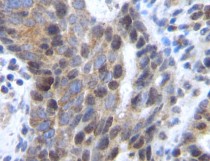ARG55893
anti-CXCL12 / SDF1 antibody
anti-CXCL12 / SDF1 antibody for ELISA,IHC-Frozen sections,IHC-Formalin-fixed paraffin-embedded sections,Neutralizing,Western blot and Human,Mouse,Rat
Overview
| Product Description | Rabbit Polyclonal antibody recognizes CXCL12 / SDF1 |
|---|---|
| Tested Reactivity | Hu, Ms, Rat |
| Tested Application | ELISA, IHC-Fr, IHC-P, Neut, WB |
| Host | Rabbit |
| Clonality | Polyclonal |
| Isotype | IgG |
| Target Name | CXCL12 / SDF1 |
| Antigen Species | Human |
| Immunogen | Recombinant Human CXCL12 / SDF1 |
| Conjugation | Un-conjugated |
| Alternate Names | TPAR1; SDF1; C-X-C motif chemokine 12; Pre-B cell growth-stimulating factor; TLSF; PBSF; SDF-1; Intercrine reduced in hepatomas; IRH; hSDF-1; 3-72; SCYB12; hIRH; Stromal cell-derived factor 1 |
Application Instructions
| Application Suggestion |
|
||||||||||||
|---|---|---|---|---|---|---|---|---|---|---|---|---|---|
| Application Note | IHC-P: Antigen Retrieval: Sodium citrate buffer (pH 6.0) * The dilutions indicate recommended starting dilutions and the optimal dilutions or concentrations should be determined by the scientist. |
Properties
| Form | Liquid |
|---|---|
| Buffer | PBS (pH 7.2) |
| Concentration | 1 mg/ml |
| Storage Instruction | For continuous use, store undiluted antibody at 2-8°C for up to a week. For long-term storage, aliquot and store at -20°C. Storage in frost free freezers is not recommended. Avoid repeated freeze/thaw cycles. Suggest spin the vial prior to opening. The antibody solution should be gently mixed before use. |
| Note | For laboratory research only, not for drug, diagnostic or other use. |
Bioinformation
| Database Links | |
|---|---|
| Gene Symbol | CXCL12 |
| Gene Full Name | chemokine (C-X-C motif) ligand 12 |
| Background | This antimicrobial gene encodes a stromal cell-derived alpha chemokine member of the intercrine family. The encoded protein functions as the ligand for the G-protein coupled receptor, chemokine (C-X-C motif) receptor 4, and plays a role in many diverse cellular functions, including embryogenesis, immune surveillance, inflammation response, tissue homeostasis, and tumor growth and metastasis. Mutations in this gene are associated with resistance to human immunodeficiency virus type 1 infections. Multiple transcript variants encoding different isoforms have been found for this gene. [provided by RefSeq, Sep 2014] |
| Function | Chemoattractant active on T-lymphocytes, monocytes, but not neutrophils. Activates the C-X-C chemokine receptor CXCR4 to induce a rapid and transient rise in the level of intracellular calcium ions and chemotaxis. Also binds to atypical chemokine receptor ACKR3, which activates the beta-arrestin pathway and acts as a scavenger receptor for SDF-1. SDF-1-beta(3-72) and SDF-1-alpha(3-67) show a reduced chemotactic activity. Binding to cell surface proteoglycans seems to inhibit formation of SDF-1-alpha(3-67) and thus to preserve activity on local sites. Acts as a positive regulator of monocyte migration and a negative regulator of monocyte adhesion via the LYN kinase. Stimulates migration of monocytes and T-lymphocytes through its receptors, CXCR4 and ACKR3, and decreases monocyte adherence to surfaces coated with ICAM-1, a ligand for beta-2 integrins. SDF1A/CXCR4 signaling axis inhibits beta-2 integrin LFA-1 mediated adhesion of monocytes to ICAM-1 through LYN kinase. Inhibits CXCR4-mediated infection by T-cell line-adapted HIV-1. Plays a protective role after myocardial infarction. Induces down-regulation and internalization of ACKR3 expressed in various cells. Has several critical functions during embryonic development; required for B-cell lymphopoiesis, myelopoiesis in bone marrow and heart ventricular septum formation. [UniProt] |
| Calculated MW | 11 kDa |
| PTM | Processed forms SDF-1-beta(3-72) and SDF-1-alpha(3-67) are produced after secretion by proteolytic cleavage of isoforms Beta and Alpha, respectively. The N-terminal processing is probably achieved by DPP4. Isoform Alpha is first cleaved at the C-terminus to yield a SDF-1-alpha(1-67) intermediate before being processed at the N-terminus. The C-terminal processing of isoform Alpha is reduced by binding to heparin and, probably, cell surface proteoglycans. |
Images (3) Click the Picture to Zoom In
-
ARG55893 anti-CXCL12 / SDF1 antibody WB image
Western blot: Rat Pancreatic tissue sample stained with ARG55893 anti-CXCL12 / SDF1 antibody.
From Menglu Gui et al. J Inflamm Res. (2023), doi: 10.2147/JIR.S415974, Fig. F4 C.
-
ARG55893 anti-CXCL12 / SDF-1 antibody IHC-P image
Immunohistochemistry: formalin-fixed, paraffin-embedded sections of Human colorectal adenocarcinoma stained with ARG55893 anti-CXCL12 / SDF-1 antibody.
-
ARG55893 anti-CXCL12 / SDF-1 antibody standard curve image
ARG55893 anti-CXCL12 / SDF-1 antibody results of a typical standard run with optical density reading at 405 - 650 nm.










